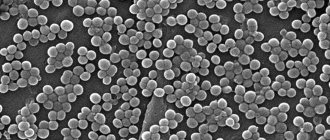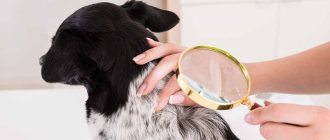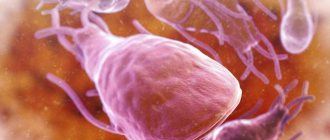Features of allergies in dogs and its classification
An allergy is an abnormally increased reaction of the body to some foreign substance that has entered it by any means. Under normal circumstances, everything foreign and harmful is simply removed from the body, but in allergy sufferers a certain inflammatory reaction occurs with the release of histamine into the blood. It is this substance that makes itself felt by redness, rashes and itching anywhere on the body.
Very often, this pathology has a genetic predisposition, and the strength of its manifestation depends on the amount of allergen that enters the body.
Features of the flow:
- more severe symptoms (especially in the manifestation of itching) than in other warm-blooded animals and humans;
- large list of allergens;
- increased manifestations over the years;
- The condition primarily affects the skin of dogs.
The most unpleasant complication of allergic reactions are scratches and wounds that appear due to strong uncontrolled scratching. Open wound surfaces serve as entry points for pathogenic bacteria, so the process is often complicated by purulent inflammation in the areas of scratching.
The parts of the body that are most often affected by allergies in dogs can be seen in the photo:
The classification of allergic reactions in dogs combines the types of allergens and the ways they enter the body.
Types of allergies:
- food allergies in dogs;
- medicinal;
- chemical (for animal care products or household chemicals);
- infectious (viral, bacterial, fungal or helminthic);
- insect (reactions to insect bites and cutaneous blood-sucking insects, i.e. allergy to fleas in dogs);
- autoimmune reactions (the rarest form).
Allergic reactions manifest themselves in two ways:
- cumulative (some time after contact with the allergen - up to several weeks);
- instantaneous (almost immediately after interaction).
Treatment and prevention of allergies in dogs
Therapy for this disease is carried out in a comprehensive manner, and the choice of treatment method depends on the form of the allergy and associated pathologies. All treatment methods have two points in common:
- Eliminating the effect of the allergen on the pet.
- The use of antihistamine - locally and generally.
In addition, the doctor develops a special, hypoallergenic diet for the period of treatment and recovery and prescribes drug therapy.
- General purpose antihistamines.
- Local antihistamines (for dermatitis).
- Antishock (for drug form and anaphylaxis).
- Antibiotic and/or antifungal (for infectious type).
- Anti-inflammatory (for otitis).
- Glucocorticoids and immunosuppressants (in the autoimmune form).
Basic preventive methods:
- Limiting contact with allergens (anthelminthic therapy, wet cleaning, etc.).
- Water hygiene (frequent washing is indicated, even daily, when allergies are diagnosed, without the use of detergents).
- Hyposensitization (immunotherapy). Injections of special components to suppress an active reaction to allergens.
- Diet. Elimination of allergenic foods and “harmful” proteins.
Allergy is not a death sentence, and modern veterinary medicine has many ways to help a pet without losing quality of life. It is enough just to consult a doctor in time.
Allergies in dogs: general and specific symptoms
The body of any animal is densely covered with hair, so signs of increased reactivity of the body do not immediately become visible. It is useful to carry out an unobtrusive examination of the skin, muzzle and ears at the moment of direct contact with the dog. It should be noted that the shorter and lighter the coat, the more pronounced and noticeable the symptoms.
The following list of symptoms may indicate that your pet has an allergy.
Locations of allergies
signs of itching (constantly scratching ears, scratching the body, gnawing or actively licking paws, rubbing against the floor or furniture);
- clear nasal discharge and lacrimation;
- peeling and redness on the pads of the paws and in the space between the toes;
- there is a rash, redness, local swelling, scratching;
- dandruff and increased dry skin;
- hair loss, bald spots without visible signs of inflammation;
- signs of inflammation in the ears;
- increased sweating in the chest and armpits (allergic effusion);
- diarrhea or frequent bowel movements without changes in stool status.
Important: dogs do not sweat in the sense in which people are accustomed to understanding the meaning of this physiological phenomenon. The sweat glands in these animals, which control thermoregulation, are located only on the pads of the paws and in the mouth area. Increased humidity in the armpits and in any other part of the body is always a sign of health problems and, most often, a symptom of an allergic reaction!
Specific signs of different types of allergies:
Food |
|
Flea dermatitis |
|
Contact dermatitis |
|
Atopic dermatitis |
|
Infectious | standard symptoms of increased reactivity accompany a primary disease of a fungal, viral or bacterial nature. |
Medicinal |
|
Allergic otitis media |
|
Autoimmune |
|
Allergy symptoms in dogs
How can you tell if your dog has an allergy? The clinical picture of the disease resembles some skin pathologies, viral infections and parasitic infestations. An accurate diagnosis can only be made in a clinical setting based on a series of studies.
General symptoms:
- Severe continuous itching. The dog itches and licks itself until it becomes bald, injuring itself.
- Tearing. Bald patches around the eyes.
- Swelling.
- Clear nasal discharge.
- Unseasonal shedding.
- Bald spots.
- Hives on the skin.
- Dry skin.
- Dandruff.
- Inflammation, peeling and redness between the fingers.
- Chronic otitis. Inflammation in the ears.
- Wetting of the chest and armpits (allergic effusion).
- Disturbances in the gastrointestinal tract. Chronic diarrhea.
Specific signs:
- Insect. Ectoparasites are visually detected. Redness of the skin. Severe itching. A small rash is localized in the groin area.
- Food. Allergic effusion. Inflammation in the oral cavity, foul odor from the mouth. Tearing. Vomiting, gastrointestinal dysfunction. Hair loss and bald spots. Rash.
- Infectious. The presence of a primary pathology of infectious origin.
- Medication. Hives. The rashes are localized on the face and have clearly defined edges. Complication – anaphylactic shock.
- Atopic. Localization areas: ears, muzzle, groin, armpits, paws. The dog licks the affected areas.
- Contact. Hives on the abdomen, groin area, paws and chin. Eczema between fingers. Irritation on paw pads.
- Respiratory. Mucous discharge from the nose. Cough, shortness of breath, wheezing. Red, swollen eyes. The dog is sneezing.
- Autoimmune. Immune dermatitis. Connective tissue diseases. Damage to mucous membranes and skin.
Photos of types of allergies
| Autoimmune cutaneous vasculitis | Allergic otitis media | Interdigital dermatitis | Drug allergy |
| Food allergies | Quincke's edema with anaphylaxis | Erythema multiforme | lupus erythematosus |
| Flea dermatitis | Hives | Atopic dermatitis | Bullous pemphigoid |
Anaphylactic shock in a dog: symptoms, first aid
Regardless of what causes anaphylaxis, it always occurs the same way. It can be local and systemic, and the first form can transform into the second. Most often it occurs due to bites or injection of drugs.
Local manifestation:
- urticaria (local redness, rash, itching);
- angioedema (under the skin and in deep tissue layers).
Systemic signs:
- vomiting and increased agitation, which is replaced by depression;
- respiratory depression;
- cardiovascular failure and possible loss of consciousness.
Important: if there is a risk or actual occurrence of anaphylactic shock, you should immediately take the animal to a veterinary hospital. You have no more than 1 hour to provide first aid to the animal, otherwise it will die!
Actions of the veterinarian:
- Immediate intramuscular administration of suprastin or diphenhydramine - 0.2 ml/kg.
- Intravenous cordiamine 0.02-0.6 ml/kg or subcutaneous sulfocamphocaine 0.2 ml/kg (supports heart function).
- Subcutaneously any of the steroids: hydrocortisone, dexamethasone or dexon - 0.5-1 mg/kg depending on the size of the dog.
- Intravenous “cocktail” of glucose and ascorbic acid in one syringe (m ml + 0.2 ml/kg).
- Intramuscularly 1 amp. immunofana.
Next, after stopping the attack within 24 hours:
- Calcium chloride from 1 to 5 tbsp. - drink during the day.
- Instead of water, it is better to drink a decoction of the string.
- Relieve itching with hydrocortisone spray 2-3 times a day (4 amps of hydrocortisone, 80 ml of alcohol, 50 ml of glycerin, 350 ml of water - put in a hand spray bottle).
Caring for a dog with allergies
Treatment of allergies in dogs should only be prescribed by a veterinarian. Depending on the age of the animal, the characteristics of its breed, the severity of food intolerance and other circumstances, the choice of medications can vary greatly. But the animal owner must adhere to the general principles of caring for a dog suffering from allergies.
- The dog should be switched to a hypoallergenic diet or foods to which its immune system is hypersensitive should be removed from its menu. It is also important to minimize the influence of factors that potentially aggravate the animal’s condition - do not walk the dog in industrial areas, near the roadway. In the warm season, you need to use repellents (unless your veterinarian recommends otherwise) to protect your pet from insect bites.
- Carefully care for your dog's skin and coat. For the entire period of treatment, the use of hard combs for combing hair should be avoided. They need to be replaced with soft brushes that do not injure the skin. It is important to choose the right dog hygiene product. One of them is the hypoallergenic shampoo for puppies and dogs with sensitive skin ELITE ORGANIC. The shampoo contains no substances that irritate your pet's skin, and extracts of medicinal plants, amino acids, silk proteins, vitamins and other substances have a soothing effect on the skin, helping it recover.
- It is necessary to control that the dog does not become hypothermic and does not come into contact with sick animals - due to allergies, its immunity is reduced, the animal is more vulnerable to infectious and other diseases.
Diagnostics
Before the diagnosis of allergy is confirmed, the veterinarian will rule out those diseases that have similar clinical manifestations. Differential diagnosis includes skin scrapings, stool analysis for helminths, trichoscopy, bacterial cultures and blood tests, etc.
Because Since the symptoms of all conditions are basically similar, the main diagnostic principle of veterinary dermatology is to exclude potential allergens one by one. The very first reasons that people pay attention to are skin parasites (fleas) and food.
To determine food reactivity, diagnostic nutrition is administered for 1.5-2 months and a protein map is drawn up. During this period, the dog's body's reactions to various food proteins are tested. All reaction results are recorded in a protein map. Products containing proteins that are reactive to the body will need to be excluded for the rest of the animal’s life. There is no other way to find out what food a dog is allergic to! Human tests are absolutely not suitable in this case.
To determine the reaction to fleas and their saliva, use a wet white paper test, visual inspection, and a trial diagnostic treatment. When testing with wet paper, red spots from “black” dandruff combed from the dog’s skin and fur will spread out on the sheet - these are traces of flea activity.
Allergies to other substances in the environment can be determined if owners are attentive to their pets. An attentive owner notices the slightest changes in the health of the pet and the reasons that caused these changes, which are then brought to the attention of the veterinarian. Also, when assuming allergies to plants and their pollen, seasonality is taken into account, and not just external signs of the disease.
Testing your dog for allergies
Testing your dog for allergies depends in part on your dog's symptoms and what your veterinarian thinks may be causing his problem. There are several main types of dog allergy tests that can help determine the cause.
Intradermal testing
The gold standard for testing a dog for environmental allergies is intradermal skin testing. For this test, your dog will need to see a veterinary dermatologist and be sedated to shave off most of his fur. She will then receive small injections of a number of different allergens and will be monitored for reactions. Shaving is necessary so that the dermatologist can examine the skin for any signs of an allergic reaction. This information is then used to create a special allergy serum to desensitize your dog to its triggers. Unfortunately, this method does not work for food allergies.
Blood analysis
The blood test method is less invasive because it only requires a blood test, but it may also be less reliable than intradermal testing. An external laboratory will test the blood for reaction to allergens, and the results can be used to formulate a special allergy serum for desensitization therapy.
© shutterstock
Diet elimination method
The gold standard for food allergy testing is the elimination diet trial. Your veterinarian will help you choose a diet with new ingredients that your dog has not had before, and your dog will have to eat only this diet for eight to twelve weeks. This may seem like a long time, but allergens take time to leave your dog's body, so it's important to stick with it and be patient.
During the test, your dog should not eat anything outside the diet, meaning no extra treats that are not approved and no table scraps. Any snack can skew the test results and force you to start over. If your dog is no longer symptomatic after twelve weeks, your veterinarian will advise you to perform a “test” and reintroduce the ingredient that is believed to be the problem. If your dog's symptoms return, then you know that this ingredient was the cause of his allergy. If it is still ok, another ingredient will be tested until the culprit is found.
Blood and saliva tests are also sold to confirm food allergies, but these tests are unreliable.
Flea allergy test
The only allergy that is easy to diagnose is flea allergy. If your veterinarian finds fleas or signs of fleas on your itchy dog, your dog will be prescribed preventive medications that repel fleas. If your dog's symptoms go away after treatment, he may have a flea allergy.
Allergy treatment
If a dog has an allergy, only a veterinarian knows how to treat it. Only a specialist must remove the body from a reactive state, because only he can distinguish non-standard reactions from some other infectious and non-communicable diseases that have a similar clinical picture.
Treatment of allergies in dogs is always complex and depends on the type of reaction and its symptomatic manifestations. But regardless of the nuances of the development of the condition, two main points of treatment are present in any case:
- Stopping exposure of the body to allergens.
- Antihistamine therapy - general and local.
Sick or recovering animals are fed with special hypoallergenic food for dogs with allergies, specially designed for such cases. You can also create your diet according to your food diary, excluding all reactive food names.
The same procedure also applies to medications - only those drugs that do not cause allergies can be administered. Drugs that have provoked a non-standard reaction at least once are usually recorded in the animal’s personal medical record or in the veterinary passport.
Features of medical care for different types of allergies:
- Food - determination of the type and elimination of food allergen through a diagnostic diet.
- Insect - removal of all cutaneous blood-sucking insects from the surface of the animal and from its environment.
- Drug - immediate antiallergic or, if necessary, antishock therapy (usually local treatment is not required).
- Infectious - determining the type of infection accompanied by an immune malfunction and eliminating it (without eliminating the cause of the allergy, antihistamine therapy will be ineffective).
- Atopic dermatitis is not completely curable, so symptomatic antihistamine therapy and local antipruritic effects will accompany the dog throughout its life.
- Autoimmune reaction - administration of massive doses of glucocorticoids to relieve exacerbation of the disease, followed by transfer to minimal maintenance doses; therapy that suppresses immune activity so that the body stops “attacking” its own cells and organs;
- symptomatic therapy, depending on which organ or system is “attacked” by the immune system.
- Allergic otitis - against the background of antihistamine therapy, general anti-inflammatory treatment of otitis is carried out.
How to determine the type of allergy in a dog
There are several main types of allergies in dogs, including:
- Atopy : The allergen is inhaled or may be airborne and affect the skin upon contact (also known as atopic dermatitis).
- Contact allergy : the allergen comes into contact with the skin. Common causes include skin reactions to flea collars, plants, fabrics, chemicals, creams and many other materials. Be sure to consult your veterinarian to better understand the cause.
- Insect bite : If your dog is allergic to fleas, bees, wasps, or arachnids such as spiders, an allergic reaction may occur after your puppy is bitten by one of these pests. Symptoms often include swelling, itching, irritation and redness of the skin, and in severe cases, difficulty breathing.
- Respiratory allergies : Like common seasonal allergies in humans, respiratory allergies occur when a dog inhales an airborne allergen such as pollen, dust, smoke, household spray or cleaning product. Common symptoms to look out for may be coughing, sneezing, wheezing and difficulty breathing (which can be serious and require a visit to the veterinarian).
- Food allergy : An allergen enters the body and causes problems such as skin irritation, vomiting, stomach upset and/or diarrhea.
Testing your dog to determine what type of allergies he suffers from will help you treat and prevent future allergic reactions.
Review of Allergy Medicines in Dogs
Due to the peculiarities of the manifestation and course of allergic reactions in dogs, the range of antihistamines allowed for use in them is quite wide. All antihistamines are divided into 3 large groups:
- drugs that reduce the response of H1/2 receptors (what reacts to histamine in the body);
- drugs that bind and remove histamine;
- drugs that prevent the production of histamine.
In dogs, drugs belonging to the first group are most often used, i.e. they reduce the body’s response to histamine circulating in the blood, relax smooth muscles, relieving spasms, reduce swelling by reducing vascular permeability and eliminate other obvious allergic symptoms. The decision on what to give your dog for allergies is made only by a veterinarian!
Diphenhydramine (diphenhydramine)It has a pronounced antihistamine sedative and anti-inflammatory effect. It is used for any reactive failures, including medicinal ones. Administered subcutaneously or intramuscularly in the form of a 1% solution twice a day. Dose: 0.6-0.8 mg/kg animal body weight. |
Diprazine (phenergan, pipolphen, allergan)Effective for dermatitis accompanied by itching. Causes drowsiness. Administered intramuscularly in the form of a 2.5% solution or tablets. Dosage: 4.5-5 mg/kg 2-3 times a day. |
Diazolin (mebhydrolin, incidal, omeril)Prescribed for allergies of unknown origin. Used internally in the form of tablets. Partially inhibits the functioning of the central nervous system. Dose calculation: 3-4 mg/kg once or twice a day. |
Suprastin (allergans)It is used for absolutely all forms of allergies. Has a slight sedative effect. Given in the form of a 2% solution. Dosage: 0.1-0.5 ml twice a day. |
Tavegil (angistan, clemastine)The therapeutic effect is similar to diphenhydramine, but with a longer lasting effect. The dosage is the same for both the 0.1% solution and the tablets: 0.015-0.02 mg/kg 1-2 times a day. |
Ketotifen (astafen, zaditen)Often used for anaphylactic shock, histamine bronchospasm and long-term systematic elimination of allergic reactions (due to the cumulative effect). Dosage: 0.02-0.05 mg/kg. Twice a day course for 2-3 months. |
Astemizole (gismanal)It works well for food allergies, urticaria and rhinitis. They ask inside. Do not use during pregnancy. Dose: 0.3-0.35 mg/kg 2-3 times a day. |
CetirizineAn excellent antiallergic drug that does not cause drowsiness. Once or twice a day. Dose: 0.25-0.5 mg/kg animal weight. |
Loratadine (Claritin)Works well for allergic rhinitis and lacrimation in dogs. Not prescribed to pregnant bitches. Approximate dosage: 0.1-0.15 mg/kg once a day. |
BicarfenAn antihistamine with a broad antiserotonin effect: allergic lacrimation and rhinitis, drug allergies and reactions to food, atopic dermatitis, neurodermatitis, hay fever. Regimen: 1-1.5 mg/kg up to two times daily for 1-2 weeks. In case of seasonal outbreaks, you can repeat the course throughout the year. |
Dog ear allergies
Ears are a vulnerable spot for pets. The dog began to shake and scratch its ears - take measures to resolve the serious problem.
Many dog breeders are wondering what to give their dog for allergies.
to avoid visiting the veterinary clinic.
At home, you can use activated carbon, smecta, suprastin for dogs with allergies,
or other drugs that quickly remove the allergen from the animal’s body. The main thing is to carefully study the instructions before use, accurately calculating the required dose of medication based on the weight of the pet. If the disease is life-threatening, droppers and intramuscular injections are used. In this case, a trip to the doctor is inevitable, because the procedure is carried out under the strict supervision of specialists.











